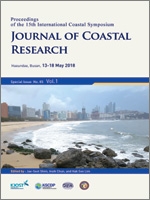Chen, X.D.; Wang, J.; Zhang C.K.; Yu S.B.; Zhou J.J.; Zhang N.Y., and Feng, Q., 2018. Biological mediation of sediment erosion: Can we account for tidal effects?. In: Shim, J.-S.; Chun, I., and Lim, H.S. (eds.), Proceedings from the International Coastal Symposium (ICS) 2018 (Busan, Republic of Korea). Journal of Coastal Research, Special Issue No. 85, pp. 421–425. Coconut Creek (Florida), ISSN 0749-0208.
Sedimentology and geomorphology have no longer been seen as fields where only physical and chemical processes dominate. Changes in shear stress due to tidal effects may lead to repeated cycles of biofilm growth, erosion, and regrowth that produce conditions different from the steady-state ones often examined in the laboratory. Therefore, repeated cycles of laboratory-controlled experiments were conducted. Algal biofilm was initially developed on the sediment bed under low shear stress (0.06 Pa). After the biofilm reached a quasi-steady state (12 days of cultivation), the bio-bed was eroded with stepwise increment of shear forces, and then allowed to re-grow for only 5 days before being eroded again. The first cycle aimed to test whether the biological cohesion could recover during a relatively short calm period. After then, it was followed by six consecutive times of repeated procedure of 5-days-growth, erosion and regrowth (two under limited nutrients and four under rich nutrients), to investigate the responses of bio-beds under frequent disturbances and different nutrients abundance. The data showed that for the first cycle, the strength of the bio-bed surprisingly restored to the similar level of the bio-bed incubated for 12 days, within a relatively short recovery period of only 5 days after the disturbance. However, with nutrients limitation, the anti-erodibility declined dramatically that after two cycles, the bed stability rapidly reverted back to the non-cohesive condition. After four cycles under high nutrients, the biological cohesion rebuilt gradually but was hard to reach to the original strength. Different from the traditional assumption, our results indicate that in intertidal zones frequent disturbances cannot entirely inhibit the establishment of bio-sediment, and the biological mediation in sediment stability still occurs without nutrients limitation.





